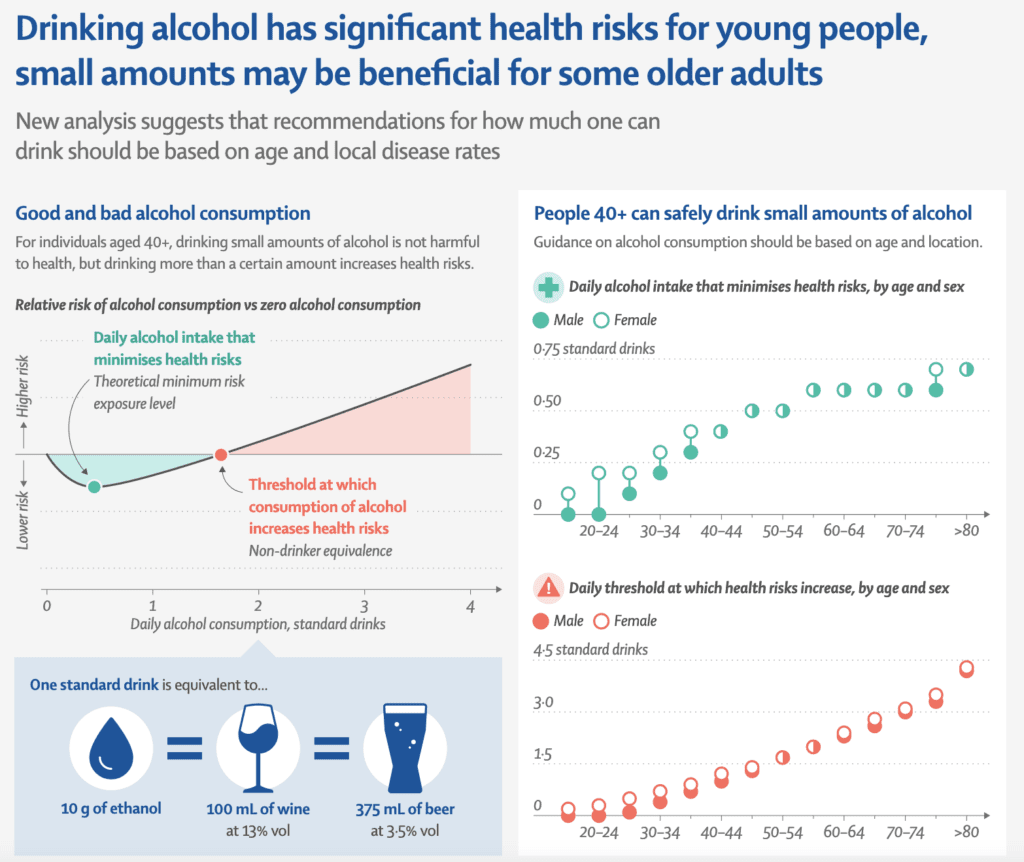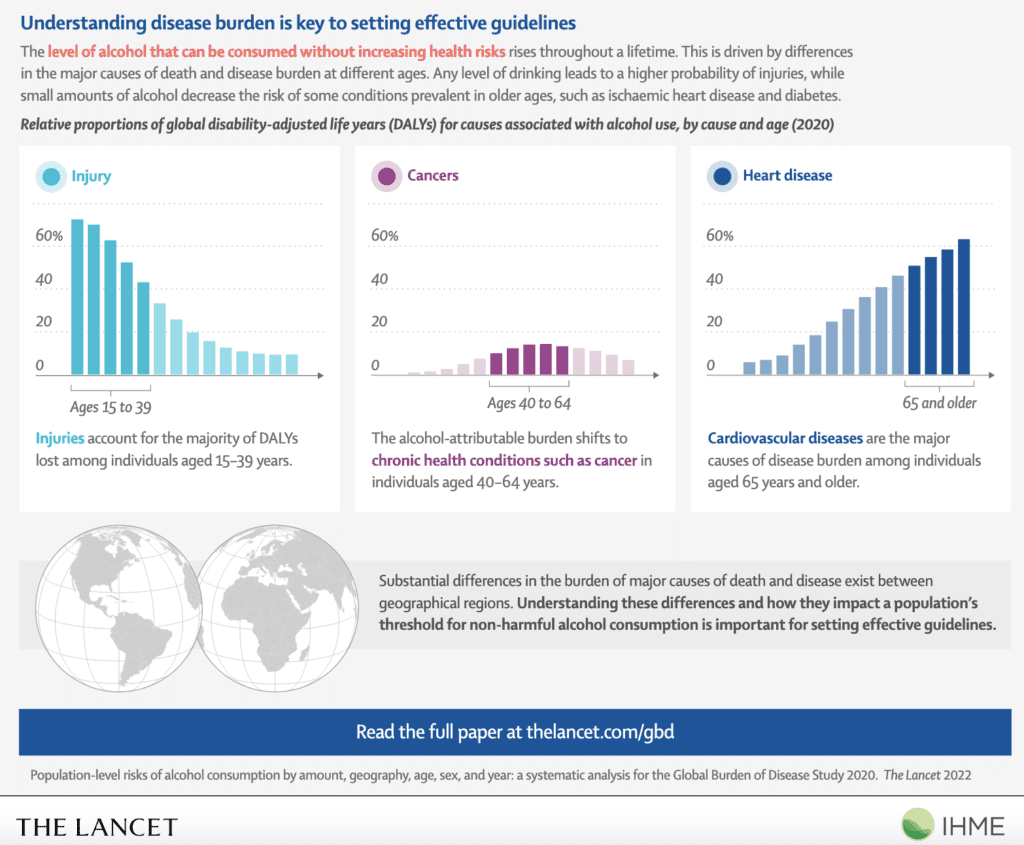Search Posts
Recent Posts
- U.S. Carries Out Limited Strike on Iran’s Known Nuclear Sites June 22, 2025
- A Greener View: E. Coli vs. Vegetables, and Your Garden – Jeff Rugg June 22, 2025
- Rhode Island Weather for June 22, 2025 – Jack Donnelly June 22, 2025
- Ask Chef Walter: The Art and Science of Baking – Chef Walter Potenza June 22, 2025
- Gimme’ Shelter: Aurora is waiting for a home at the Providence Animal Control Center June 22, 2025
Categories
Subscribe!
Thanks for subscribing! Please check your email for further instructions.

Study calls for new alcohol guidelines as moderate use by under-40s, particularly males, pose higher health risks
The health risks associated with moderate alcohol consumption continue to be debated. Small amounts of alcohol might lower the risk of some health outcomes but increase the risk of others, suggesting that the overall risk depends, in part, on background disease rates, which vary by region, age, sex, and year.
Summary:
- The new analysis from the Global Burden of Disease estimates that 1.34 billion people consumed harmful amounts of alcohol (1.03 billion males and 0.312 billion females) in 2020.
- The analysis suggests that for young adults ages 15–39, there are no health benefits to drinking alcohol, only health risks, with 59.1% of people who consumed unsafe amounts of alcohol in 2020 between ages 15 and 39 years and 76.7% male.
- The authors note that given the complex relationship between alcohol and diseases and different background rates of diseases across the world, the risks of alcohol consumption differ by age and by geographic location.
- For people over age 40, health risks from alcohol consumption vary by age and region. Consuming a small amount of alcohol (for example, drinking between one and two 3.4-ounce glasses of red wine) for people in this age group can provide some health benefits, such as reducing the risk of cardiovascular disease, stroke, and diabetes.
- Authors call for alcohol consumption guidelines to be revised to emphasize consumption levels by age, stressing that the level of alcohol consumption recommended by many existing guidelines is too high for young people in all regions. They also call for policies targeting males under age 40, who are most likely to use alcohol harmfully.
Young people face higher health risks from alcohol consumption than older adults, according to a new analysis published in The Lancet. This is the first study to report alcohol risk by geographical region, age, sex, and year. It suggests that global alcohol consumption recommendations should be based on age and location, with the strictest guidelines targeted toward males between ages 15 and 39, who are at the greatest risk of harmful alcohol consumption worldwide.
The research also indicates that people aged 40 and older without underlying health conditions may see some benefits from small alcohol consumption (between one and two standard drinks per day [1]), including a reduced risk in cardiovascular disease, stroke, and diabetes.
Using estimates of alcohol use in 204 countries, researchers calculated that 1.34 billion people consumed harmful amounts in 2020. In every region, the largest segment of the population drinking unsafe amounts of alcohol were males aged 15–39 and for this age group, drinking alcohol does not provide any health benefits and presents many health risks, with 60% of alcohol-related injuries occurring among people in this age group, including motor vehicle accidents, suicides, and homicides.
“Our message is simple: young people should not drink, but older people may benefit from drinking small amounts. While it may not be realistic to think young adults will abstain from drinking, we do think it’s important to communicate the latest evidence so that everyone can make informed decisions about their health,” says senior author Dr. Emmanuela Gakidou, Professor of Health Metrics Sciences at the Institute for Health Metrics and Evaluation (IHME) at the University of Washington’s School of Medicine. [2]


Age and region should drive alcohol consumption policies
The researchers looked at the risk of alcohol consumption on 22 health outcomes, including injuries, cardiovascular diseases, and cancers [3] using 2020 Global Burden of Disease data for males and females aged 15–95 years and older between 1990 and 2020, in 204 countries and territories. From this, the researchers were able to estimate the average daily intake of alcohol that minimizes risk to a population. The study also estimates another critical quantity – how much alcohol a person can drink before taking on excess risk to their health compared to someone who does not drink any alcohol.
The recommended amount of alcohol for people aged 15–39 before risking health loss was 0.136 standard drinks per day (a little more than one-tenth of a standard drink). That amount was slightly higher for females aged 15–39 years at 0.273 drinks per day (about a quarter of a standard drink). One standard drink is defined as 10 grams of pure alcohol, which is equivalent to a small glass of red wine (100ml or 3.4 fluid ounces) at 13% alcohol by volume, a can or bottle of beer (375 ml or 12 fluid ounces) at 3.5% alcohol by volume, or a shot of whiskey or other spirits (30 ml or 1.0 fluid ounces) at 40% alcohol by volume. [1]
The analysis also suggests that for people aged 40 and older without any underlying health conditions, drinking a small amount of alcohol may provide some benefits, such as reducing the risk of ischemic heart disease, stroke, and diabetes. In general, for individuals aged 40–64 years in 2020, safe alcohol consumption levels ranged from about half a standard drink per day (0.527 drinks for males and 0.562 standard drinks for females) to almost two standard drinks per day (1.69 standard drinks for males and 1.82 for females). For individuals over 65 years in 2020, the risks of health loss from alcohol consumption was reached after consuming a little more than three standard drinks per day (3.19 drinks for males and 3.51 for females). The estimates suggest that small amounts of alcohol consumption in people over 40 without underlying conditions may be associated with improved health outcomes, particularly in populations that predominantly face a higher burden of cardiovascular diseases.
The distribution of disease burden for a given age group varied substantially across regions, resulting in variations in risks from alcohol consumption, particularly in individuals aged 40 years and older. For example, among individuals aged 55–59 years in North Africa and the Middle East, 30.7% of alcohol-related health risks were due to cardiovascular disease, 12.6% were due to cancers, and less than 1% were due to tuberculosis. By contrast, in this same age group in central sub-Saharan Africa, 20% of alcohol-related health risks were due to cardiovascular disease, 9.8% to cancers, and 10.1% to tuberculosis. As a result, consumption levels for this age group before risking health loss were 0.876 drinks (or almost one standard drink per day) in North Africa and the Middle East and 0.596 drinks (about half a standard drink per day) in Central sub-Saharan Africa.
Overall, the recommended alcohol intake for adults remained low, at between 0 and 1.87 standard drinks per day, regardless of geography, age, sex, or year.
“Even if a conservative approach is taken and the lowest level of safe consumption is used to set policy recommendations, this implies that the recommended level of alcohol consumption is still too high for younger populations. Our estimates, based on currently available evidence, support guidelines that differ by age and region. Understanding the variation in the level of alcohol consumption that minimizes the risk of health loss for populations can aid in setting effective consumption guidelines, supporting alcohol control policies, monitoring progress in reducing harmful alcohol use, and designing public health risk messaging,” says lead author Dana Bryazka, researcher at IHME.
Young men are at greatest risk of harmful alcohol consumption
Using these estimates, the proportion of the population consuming alcohol in amounts exceeding these thresholds by location, age, sex, and year, was also calculated, serving as a guide for targeting alcohol control efforts.
Among individuals consuming harmful amounts of alcohol in 2020, 59.1% were age 15–39 years, and 76.7% were male, with 1.03 billion males and 0.312 billion females drinking harmful amounts of alcohol. Harmful use of alcohol was particularly concentrated in young males in Australasia, Western Europe, and Central Europe.
“Although the risks associated with alcohol consumption are similar for males and females, young males stood out as the group with the highest level of harmful alcohol consumption. This is because a larger proportion of males compared to females consume alcohol and their average level of consumption is also significantly higher,” says Dr. Gakidou.
The authors acknowledge some limitations with this paper, including that patterns of drinking were not examined. Therefore, this study did not distinguish between individuals who infrequently engage in heavy episodic drinking and those who consume the same amount of alcohol over several days. Alcohol consumption was also self-reported, which could have introduced bias, and the study could not include data on consumption during the COVID-19 pandemic due to pandemic-related delays with routine data collection, which could also have affected these estimates.
Writing in a linked Comment, Robyn Burton and Nick Sheron of King’s College London (who were not involved in the study) say, “These findings seemingly contradict a previous GBD estimate published in The Lancet, which emphasized that any alcohol use, regardless of amount, leads to health loss across populations. There are three main differences between the two GBD publications. First, the most recent study uses data from 2020 instead of 2016. Second, the relative risk curves for five alcohol-related outcomes have been updated. However, neither of these changes is driving the differences in results. Instead, the differences are due to the novel method of weighting relative risk curves according to levels of underlying disease, alongside the calculation of more disaggregated estimates by sex, age, and geographical region. The causes that contribute to all-cause mortality vary across groups, and this changes the proportional risk of alcohol on mortality. Across most geographical regions in this latest analysis, injuries accounted for most alcohol-related harm in younger age groups. This led to a minimum risk level of zero, or very close to zero, among individuals aged 15–39 years across all geographical regions. This is lower than the level estimated for older adults, due to a shift in alcohol-related disease burden towards cardiovascular disease and cancers. This highlights the need to consider existing rates of disease in a population when trying to determine the total harm posed by alcohol.”
___
This study was funded by the Bill and Melinda Gates Foundation. A full list of GBD 2020 Alcohol Collaborators is available in the paper.
[1] One standard drink is defined as 10 grams of pure alcohol. Examples include:
- A small glass of red wine (100ml or 3.4 fluid ounces) at 13% alcohol by volume;
- A can or bottle of beer (375 ml or 12 fluid ounces) at 3.5% alcohol by volume; or
- A shot of whiskey or other spirits (30 ml or 1.0 fluid ounces) at 40% alcohol by volume.
[2] Quote direct from author and cannot be found in the text of the Article.
[3] These health issues included:
- Ischemic stroke, intracerebral hemorrhage, ischemic heart disease, hypertensive heart disease, and atrial fibrillation and flutter
- Cancers, including lip and oral cavity cancer, nasopharynx cancer, other pharynx cancer, esophageal cancer, larynx cancer, colon and rectum cancer, breast cancer, and liver cancer
- Type 2 diabetes, cirrhosis, and other chronic diseases of the liver, pancreatitis, idiopathic epilepsy, and tuberculosis
- Transport injuries, unintentional injuries, self-harm, and interpersonal violence
The study was published in The Lancet – and funded by the Bill & Melinda Gates Foundation.
